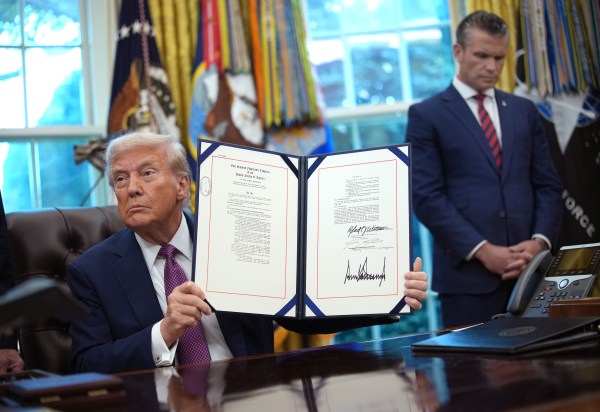An image comparing budget deficits and surpluses for Republican and Democratic presidents has spread across social media this week. “The budget has always been better under democrats,” reads a quote attributed to Donald Trump above a table listing budget deficit and surplus numbers for each president since Reagan. “NOTICE A PATTERN???” it then asks. The graphic, which first emerged in 2023, gained new virality after it was posted by progressive organization Occupy Democrats on Facebook and Instagram this week. The image, which has gained more than 40,000 likes across both platforms, puts forward two arguments: 1) that Republican presidents have run higher deficits than Democratic presidents, and 2) that the Biden administration has cut deficits drastically since taking office.
One issue with the graphic is that some of the numbers it references are simply incorrect. For example, George W. Bush did not leave office with a $1.4 trillion deficit. That deficit was accumulated over the course of fiscal year 2009, during which Obama was president for more than nine months. Likewise, the deficit in Reagan’s final year was around $155 billion, not $175 billion as the image claims.
The graphic leverages these inaccurate deficit and surplus numbers and then uses them selectively to make it appear that Democratic administrations have consistently run smaller deficits than their Republican counterparts. In reality, every president listed in the graphic oversaw a net increase in budget deficits over the course of their presidency, and Democrats Barack Obama and Joe Biden recorded the highest net deficits of all. Likewise, while Biden did decrease the deficit from record highs during the COVID-19 pandemic, his administration has still overseen significantly larger deficits than Trump did before the pandemic.
The most significant issue, however, is the graphic’s use of federal budget deficits and surpluses as a measure of fiscal responsibility for each president. Absolute deficit and surplus figures do not take inflation or percentage of GDP into account, meaning comparisons inherently ignore changes in economic growth and price levels. Such figures also overlook the role of Congress in federal spending, and are often affected significantly by single-year anomalies such as the 2008 housing crash or 2020 COVID-19 pandemic. For this reason, they do not accurately represent an individual president’s influence on the national debt.
What’s the actual data?
First, let’s address the graphic’s comparison of individual budget surpluses and deficits. Comparing budget deficits/surpluses from only a president’s first and final months in office ignores any and all spending that occurs in the intervening period, resulting in a comparison that doesn’t actually tell us anything about the budget across the entirety of a presidency. Likewise, this kind of contrast allows an outlier fiscal year budget to dramatically influence the points of comparison being used. On the graphic’s own terms, it would be more accurate to compare monthly budget deficit/surplus data across the entirety of a president’s time in office to analyze an administration’s total contribution to the federal debt.
Using this monthly budget data, here is a rundown of the total debt accumulated during each president’s respective administration:
- Ronald Reagan (1981 - 1989): $1.3 trillion
- George H.W. Bush (1989 - 1993): $958.1 billion
- Bill Clinton (1993 - 2001): $156.7 billion
- George W. Bush (2001 - 2009): $2.47 trillion
- Barack Obama (2009 - 2017): $7.04 trillion
- Donald Trump (2017 - 2021): $6.14 trillion
- Joe Biden (2021 - present): $6.17 trillion (as of March 2024)
While this is a more accurate point of comparison than the data used in the graphic, it is still not an effective way to actually compare the fiscal or economic performance of various administrations. “Some presidents inherit a baseline of soaring deficits, others inherit a baseline of budget surpluses, and their ability to alter those dials is quite limited,” Brian Riedl, economist at the Manhattan Institute, told The Dispatch Fact Check. Presidents do have influence over budget deficits and surpluses, but they also inherit spending bills passed during previous administrations, are subjected to Congress’ power of the purse, and must react to broader economic trends outside of their direct control. “These deficit partisan effects mostly disappear if one correctly: 1) Measures deficits over the entire presidency; 2) Incorporates the role of Congress passing the bills; 3) Adjusts for inherited factors such as recessions, etc; and 4) Measures presidents by legislation enacted evolving baseline factors,” Riedl explained in an email.
Presidents have very little control over deficits, Riedl notes, so using them as a point of comparison often leads to poor analysis and incorrect conclusions. “Presidents inherit a baseline of either rising or falling deficits that is almost entirely on autopilot,” Riedl said. “They cannot unilaterally adjust taxes or mandatory spending, they must first persuade Congress to pass legislation altering those policies.”
How should we compare presidential spending?
Presidents not only have little control over inherited budget baselines, they have similarly limited control over broad economic trends. As a result, a better measure of presidential contributions to deficit spending is the aggregate cost of legislation signed by each president himself.
According to analysis conducted by Riedl in 2023, President George W. Bush added $6.94 trillion in legislative spending between 2001 and 2009, most of which derived from his 2001 and 2003 tax cuts and heightened defense spending following the invasions of Iraq and Afghanistan. Obama contributed an additional $4.99 trillion during his eight years in office, the majority of which resulted from extensions to the Bush tax cuts and changes to the alternative minimum tax. Trump’s single-term legislative spending surpassed both Bush and Obama’s, reaching $7.79 trillion in four years. This increase is largely attributable to the government’s COVID-19 response in those years, which added $3.94 trillion in additional deficits—more than double the $1.97 trillion added by the administration's 2017 tax cuts.
So, did Biden actually “slice the budget deficit in half” in 2022 as the graphic claims? Biden has routinely taken credit for decreases in the federal budget deficit throughout his administration, but these claims are misleading and have been refuted repeatedly. While the deficit did actually decrease by half in 2022, research by the Committee for a Responsible Federal Budget—a nonprofit organization dedicated to promoting fiscal responsibility—found that the expiration of COVID-19 spending accounted for the entirety of the year’s deficit reduction, meaning Biden was not himself responsible for the cuts. In 2022 and 2023, deficits still remained significantly higher than pre-pandemic levels, and Biden has already approved at least $4.8 trillion in new spending over the next decade. “Biden didn’t reduce the deficit—the pandemic spending expired on schedule, and Biden gave away a healthy portion of those savings,” Riedl said. “Then he doubled the deficit in 2023.”
If you have a claim you would like to see us fact check, please send us an email at factcheck@thedispatch.com. If you would like to suggest a correction to this piece or any other Dispatch article, please email corrections@thedispatch.com.







Please note that we at The Dispatch hold ourselves, our work, and our commenters to a higher standard than other places on the internet. We welcome comments that foster genuine debate or discussion—including comments critical of us or our work—but responses that include ad hominem attacks on fellow Dispatch members or are intended to stoke fear and anger may be moderated.
With your membership, you only have the ability to comment on The Morning Dispatch articles. Consider upgrading to join the conversation everywhere.